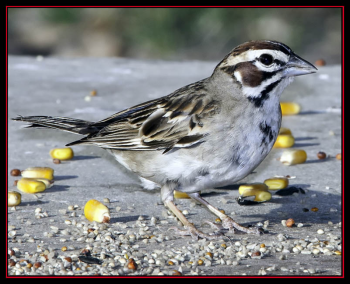Yucky Places for Birders - and Birds?
What’s the weirdest or most unappealing place you’ve ever gone birding?
That’s a question we pondered recently as we perused flocks of house sparrows in a McDonald’s parking lot at a busy urban intersection in Westbrook recently. We were there because a rare lark sparrow, a grassland species that breeds only as close western Ohio, had taken up temporary residence in this unexpected location. We had hoped to see the bird and add it to the tally for our Maine Mindfulness Big Year that we have written about a number of times over the past year.
The bird had been there for a number of days already so the chances of it remaining were getting slimmer. But we found ourselves just a few minutes away while doing something else so we decided to bop over and give it a try.
We won’t try to pass this place off as peaceful or serene in any way. On the other hand, it is rather interesting in its own way to study in more detail the goings on of house sparrows and pigeons and the spectrum of people who pass through a busy McDonald’s over the course of several hours.
Needless to say, we failed in our quest to see the lark sparrow.
The time there did make us reminiscence about other gnarly urban places where we have looked for good birds. Just about every birder eventually spends some significant time at those stinky places we used to call “dumps” but that are now given the more sanitized name of “landfills.” We have certainly passed many, many hours scanning through gulls at dumps in search of the more unusual species. One of the most memorable dump visits we’ve had was to the Brownsville, Texas, dump where we went to look for Mexican crows (unsuccessfully) but where we ran into some old birding friends we knew from New Jersey Audubon’s World Series of Birding.
During the course of past times scouting or competing in that event, there were some truly scary urban birding experiences including a 2 a.m. stop at a parking lot near a marsh in Kearny, New Jersey. Cars thumped loud rap music and large jet planes passed low overhead as they took off from nearby Newark Airport as we listened for the cackling of moorhens and tried to listen for rails in the Hackensack Meadowlands. Fortunately, the boot we saw sticking up from the marsh was not attached to a body.
Even last year during our searches for the famous Great Black Hawk that used Deering Oaks Park in Portland as its home base, we sometimes found ourselves walking the gritty urban streets nearby. It was an adventure, but it wasn’t our preferred place to look for birds and absorb the sights and sounds of nature.
Times like these, in such unexpected places, remind us as we carry on our Mindfulness Big Year, that birds themselves find themselves in places they might also not expect. Yet they are often resilient enough to thrive, or at least survive until they can move on. Just as we do.
Jeffrey V. Wells, Ph.D., is a Fellow of the Cornell Lab of Ornithology. Dr. Wells is one of the nation's leading bird experts and conservation biologists and is Vice President for Boreal Conservation for National Audubon. He is author of the “Birder’s Conservation Handbook.” His grandfather, the late John Chase, was a columnist for the Boothbay Register for many years. Allison Childs Wells, formerly of the Cornell Lab of Ornithology, is a senior director at the Natural Resources Council of Maine, a nonprofit membership organization working statewide to protect the nature of Maine. Both are widely published natural history writers and are the authors of the popular books, “Maine’s Favorite Birds” (Tilbury House) and “Birds of Aruba, Bonaire, and Curaçao: A Site and Field Guide,” (Cornell University Press).





























